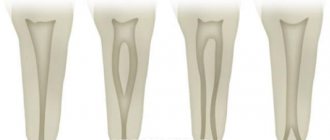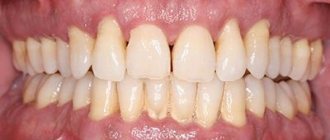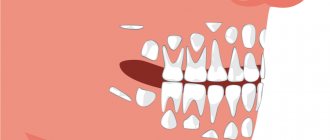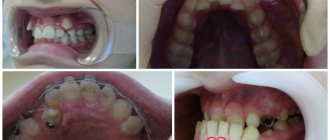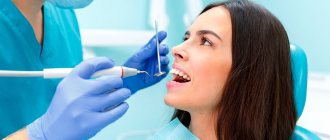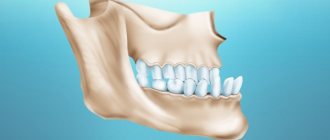Keep the norm
Teeth are the part of our body that we least want to take care of at an early age. Daily hygiene twice a day seems excessive, and going to the dentist is useless. And if you did not accustom your child to preventive care at the dentist at a tender age, then it is worth doing this during the puberty period. After all, it is precisely the difficult adolescence that becomes difficult for teeth. Since, at this time, they not only finally change from milk to radical, but are formed structurally.
How many baby teeth do children have?
Milk teeth and even some molars begin to form at the stage of intrauterine development. Of course, a child has no visible teeth at birth - they begin to erupt only after 6 months. During this six-month period, they are hidden under the gums, but slowly develop and form, beginning to move outward.
In total, a child grows 20 baby teeth:
- Central and lateral incisors – 8.
- Fangs – 4.
- First and second molars – 8.
Their main function is to form a space where molars will then grow.
Anatomy of permanent teeth
The molar tooth includes three zones: the root, which sits deep in the jaw socket and holds the tooth in place, the neck, located in the periodontal area, and the crown, which extends directly into the oral cavity. After the apex of the tooth appears, a protective film forms on the enamel, the strongest layer of the tooth, which is soon replaced by a salivary layer, formed from the saliva itself. The dental tissues themselves are not just a piece of bone, but a certain heterogeneity, which includes, in addition to enamel, dentin (the main substance of the tooth) and the dental cavity, in which nerves and blood vessels branch. Compared to bones, for example, the phalanges of the fingers, dentin is noticeably stronger - it contains an increased amount of minerals, for example, the same calcium-based compounds. The root zone of dentin is connected to the periodontium using a special layer - dental cement, which communicates with the tissues of the periodontium itself and supplies the dentin with nutrients.
How many teeth should a child have per year?
During this period, baby teeth begin to cut.
They begin to break out in the following sequence on the upper and lower jaws. On the top:
- 8-12 months. Central incisors.
- 9-13 months. Lateral incisors.
- 16-22 months. Fangs.
- 13-19 months. First molars.
- 25-33 months. Second molars.
In the lower jaw, this process is distributed in time somewhat differently:
- 6-10 months. Central incisors.
- 10-16 months. Lateral incisors.
- 17-23 months. Fangs.
- 14-18 months. First molars.
- 23-31 months. Second molars.
It is worth noting that these time limits are averaged and deviations up or down by 1-3 months are considered normal.
If you want to know how many teeth a child has per year is considered normal, you should refer to the chart described above. You get that at the age of 12 months there should be 6-8 of them.
Malocclusion in a teenager
Malocclusion or “crooked teeth” is a fairly common occurrence for children, regardless of gender, place of residence or lifestyle. These are rather the consequences of genetics, which can echo through generations. One way or another, there is no particular point in thinking and trying to understand this. You just need to treat it, contact a specialist. The meaning of this treatment is as follows:
- Smooth and healthy teeth receive nutrition from the body more fully
- less spoilage due to good hygiene
- implantation and prosthetics procedures in adulthood
- It’s trite, but a person becomes happier and more satisfied with his appearance, which directly affects future health.
Therefore, get involved and the sooner the better!
Plates and braces are orthodontic structures that are typical for adolescence. The main reason for their acquisition is malocclusion . Today, 90% of boys and girls face this problem. It is difficult to protect a teenager from this problem. Malocclusion is a consequence not only of genetic characteristics and bad habits in childhood. Most often, this problem occurs due to chronic diseases and injuries. Uneven teeth not only spoil the appearance, but can also subsequently cause tooth decay and early tooth loss. As you know, as a teenager you want to try everything.
Changing baby teeth to molars
Around the age of 4, a child’s growth spurt begins, the jaws enlarge and the baby teeth seem to move apart, with gaps appearing between them – trema. If this does not happen and by the age of 5 the teeth are still tight, you need to show the child to the dentist, as there may not be enough space for permanent teeth.
At about 5-6 years of age, baby teeth begin to become loose and gradually fall out, which indicates that the molars are already beginning to grow underneath them. Usually this process of change lasts for 5-8 years and the final formation of the dentition occurs somewhere around 14-15 years.
This happens in the following order:
- 5-6 years – lower and upper incisors.
- 7-8 years – lower and upper lateral incisors.
- 8-10 years – upper and lower molars.
- 9-11 years – upper and lower canines.
- 11-13 years – upper and lower molars.
Milk teeth are replaced by permanent molars. Their number at the age of 14-16 years is 28. At the same time, the third molars (wisdom teeth) are already formed, but they begin to grow only after 18 years. True, not all people grow them. It all depends on individual characteristics.
Is chewing gum good for you?
The cult of chewing gum and whitening toothpaste at a young age does not add health to your teeth. Not only do teenagers chew gum for more than 15 minutes (this process can take several hours), but they also use it repeatedly. Chewing gum really cleans the mouth. However, only in the first minutes. Afterwards, it becomes a breeding ground for bacteria and plaque on thin enamel. Within a few hours in the mouth, 2 cubes of chewy sweetness can cause caries.
Striving for a stellar smile can lead to complete destruction of the enamel. Therefore, when at the age of 30 you want to show off your white teeth, you will have to spend a lot on replacing them. To prevent this from happening, you should contact a dental clinic, where they will select a program for gentle enamel cleaning. to become the owner of a “ Hollywood smile ”. Firstly, thanks to professional teeth cleaning to remove plaque and tartar. The dentist, using a sand-saline solution and an ultrasound machine, literally removes plaque from the teeth. This method can lighten the enamel by a tone or two, but not lighter than the natural color. This procedure is necessary in youth. It is not only possible, but also must be carried out every six months. Thanks to which your teeth will be healthier and cleaner.
Sometimes doctors offer gel teeth whitening. This is a long-lasting and invisible way to whiten and make your teeth lighter. Its advantage: safety for health and a very stable result. And lastly, clinics often use whitening strips. They contain peroxide and work many times better than any other method. However, due to the acid content, teenagers should avoid it.
How many teeth should a child have?
It all depends on age. The maximum number of teeth in the period from birth to 5-6 years is 20 - these are milk teeth. Then, until the age of 15-16, the molars begin to erupt, pushing out the milk teeth. Ultimately, their number grows to 28.
The latest are the third molars. They grow only after 18 years of age, but not everyone has them.
It is worth noting that the period of formation and eruption of baby teeth is very individual. In some children, all 20 teeth grow by the age of 2, while in others - by 2.5 or later. Such delays within a year are considered normal and are not a developmental anomaly.
If teeth do not start cutting in the first year of the baby’s life, you should consult a doctor to find out the reasons.
To the list of posts
Advice for teenagers
In order for a young man to smile widely, he needs to monitor and care for his dental health correctly:
- Brush your teeth and floss twice a day to avoid plaque deposits;
- limit the consumption of sweets and starchy foods, create a diet of foods that do not harm teeth;
- undergo regular dental examinations;
- if a malocclusion develops, visit an orthodontist, who will recommend the best treatment option - braces, dental plates;
- if a teenager is involved in active sports, then he should wear protective mouthguards to protect his teeth and gums from injury;
- avoid bad habits such as smoking, which causes plaque deposits, bad breath and can lead to cancer;
- if you want to somehow express yourself and make yourself a piece of jewelry, for example, tongue or lip piercing, you don’t need to do it in unsanitary conditions, it’s better to go to the dentist, talk about your desire, and he will advise what measures should be taken;
- It is impossible to whiten your teeth at home, but you can maintain whiteness after professional whitening with the help of whitening pastes; in no case should you use chemical elements to make your smile snow-white on your own, without the supervision of a doctor.
It is important for parents to understand that teenagers are children, but they cannot simply be ordered around. They need to be taught, mentored, and shown a positive example of a healthy lifestyle. And it is very important to teach him to take care of his oral and dental health and regularly visit the dentist and make visits to the doctor every six months a habit that he will take with him into adulthood.
What to do?
The presence of supernumerary teeth is an abnormal phenomenon, so the issue of eliminating this problem must be resolved. How, this is another question, to give an unambiguous answer to which is impossible. As a rule, there can be several ways to solve a problem. The choice of treatment method depends on where the extra tooth is located, what shape it is, and what stage of eruption it is at.
Facilitating teething in baby
Drug treatment allows you to relieve unpleasant and painful symptoms during the eruption of excess buds. This option is the only one for children with baby teeth if the tooth is only at the eruption stage. When it finally germinates, it will be necessary to use more radical methods. The dentist prescribes medications that will help relieve pain, reduce fever and stop the inflammatory process in the soft tissues of the gums.
Simple tooth extraction
Surgery. This method is the fastest and most effective, since removing an extra tooth easily solves the problem and relieves a person from unpleasant sensations and discomfort. This treatment method is used when there is too little space in the dentition for an extra tooth or there is no space at all. Most often, supernumerary teeth are removed when there is crowding of the teeth. To free up some space in the dentition, the wisdom teeth are removed first, and if this was not enough, the premolars are also removed.
Braces and other orthodontic treatment methods
Orthodontic treatment is a method that involves correcting the bite, straightening the teeth, etc. The result is achieved by installing braces or other orthodontic structures that allow you to straighten crooked teeth and return them to their place, where they should be. The duration of wearing braces depends on many factors:
- the age of the patient (children have their own specifics);
- complexity of the situation;
- locations of supernumerary teeth and others.
At the first and second stages of the disease, the doctor may decide to install special expansion plates or aligners. Can also apply the separation method.
Consequences of poor quality treatment
If the treatment is not well-carried out, impacted teeth will continue to interfere with the normal development of the bite and dentition, which causes a violation of chewing ability, leading to a number of problems with the gastrointestinal tract, and impaired diction, which negatively affects pronunciation and pronunciation. Also, after unsuccessful treatment, healthy teeth that are located next to the additional one may begin to deteriorate.
Preventive measures
The essence of preventing dental anomalies is to eliminate the possible causes of their appearance even at the stage of formation of rudiments, that is, all responsibility for possible dental anomalies depends entirely on the child’s mother.
To prevent this unpleasant phenomenon, you need to eat right, food should be balanced and healthy. It is important to give up bad habits and follow your doctor’s recommendations. When the baby is small, you need to make sure that he does not suck his finger or pacifier for more than a year and regularly take him for examinations to the dentist for timely detection and elimination of dental problems. Moscow metro station Zvezdnaya, Danube Avenue, 23
What does the dental formula look like in a medical record?
The dental formula of an adult, as well as a child, in the medical record of a dental patient looks in the form of a schematic table (Fig. 5), which will reflect only the serial numbers of permanent or baby teeth.
Directly in this formula, the doctor will mark the missing teeth (in this case, the number is crossed out with a cross), which teeth are affected by caries, pulpitis or periodontitis, as well as which of them have crowns or bridges. Dental formula in the form of a table in the medical record –
Time of start of eruption
The appearance of the first tooth is a holiday for the whole family, but only a loving mother and an attentive father know how much anxiety and worries are associated with this event. A couple of days, or even weeks, before the first external signs of teething appear, children cry, are capricious, and lose their appetite. Moms are having a hard time—sleepless nights.
The central tooth below can grow even at eleven months. The timing of teething is individual for each baby. For almost all babies, only the symptoms of a tooth appearing remain the same. And even a professional doctor cannot determine exactly how many months the process of jaw formation will begin.
Main means and rules of care
A toothbrush and toothpaste are the main tools for caring for a child’s oral cavity. They should be chosen with great care.
How to choose a toothbrush
A common mistake is choosing a brush with too stiff bristles. Do not buy these so as not to injure the delicate gums and developing enamel of the child’s teeth. The bristles should be soft or medium soft, the brush head should be small. It would be good if the brush had a non-slip handle. Be sure to teach your child the correct cleaning technique - the movements should be sweeping, from top to bottom on the upper jaw and from bottom to top on the lower jaw. Movements from left to right not only leave uncleaned plaque on the teeth, but also damage the enamel.
A manual brush cleans plaque no worse than an electric one, but only if the cleaning technique is perfect. In addition, electric brushes, due to their bright design and unusual design, are more popular with children; with their help, it is easier to instill a love for oral hygiene. Remember that until around age 11, when your child's motor skills are fully developed, you still need to supervise his brushing.
How to choose toothpaste
Buy pastes containing strengthening components: hydroxyapatite, calcium or fluorine. They will help strengthen the enamel and prevent the development of caries. The optimal concentration of fluorides in the paste is up to 900 ppm (that is, 900 parts per million). Pastes with higher concentrations are used only in courses and as prescribed by a doctor. Remineralizing gels will provide excellent additional protection against caries.
Biorepair Junior toothpaste with mint flavor (from 6 to 12 years)
Tooth gel GC Tooth Mousse Multifruit
Gel for strengthening teeth ROCS (ROCS) Medical Minerals with fruit flavor…
Do not buy toothpastes with a high index of abrasiveness (RDA) - they polish and brighten teeth, but can damage the enamel. Pastes with an abrasiveness of up to 50 RDA are suitable for teenagers; this is enough for gentle cleansing. For whitening, it is better to choose toothpastes with natural enzymes (bromelain and papain). Pastes should not contain parabens or foaming agents (SLS, SLES).
Additional tools
Additional, but no less important components of care are dental floss and an irrigator (its use is mandatory if the child wears braces). With the help of these tools, the child will be able to thoroughly clean the interdental spaces that no brush can handle, even with the perfect cleaning technique. It is also a good idea to use rinses or special foams. They are convenient to use when it is not possible to brush your teeth, for example, at school or while traveling.
The natural sweetener xylitol will be a good helper in caring for your child’s teeth. It is added not only to candies and chewing gum, which can usefully replace regular ones, but also to toothpastes. The xylitol in their composition helps fight cariogenic bacteria and also takes care of the gums.
Chewing gum miradent Xylitol For Kids apple
Lollipops miradent Xylitol Drops mint
Chewing gum The Humble Co. Tropical Fruits
Fuzzy Rock Xylitol Crystals, Sugar Free, Peach Flavor
First signs of teething
You can recognize the imminent appearance of a tooth in a baby by the following external signs and changes in behavior:
- Crawling babies put their fingers and everything they see into their mouths. Their gums itch.
- Saliva floods my blouse and prevents me from sleeping at night.
- Sleep and appetite are disturbed.
- The gums swell and turn red.
- A couple of days before teething, a runny nose appears and sometimes a cough.
- The stool becomes liquid, mushy with a yellow, green tint.
- The temperature rises within acceptable limits.
- Whims, tears, crying are suddenly replaced by laughter and good mood. The child does not know what he wants, often asks to be held, and worries without his parents.
A baby, even at one or one and a half years old, experiences stress. Mothers need to understand and forgive the baby for his whims and disturbing dreams. Try to help during this difficult period for everyone. Do not get angry or yell at your daughter or son under any circumstances. Newborns do not yet know how to patiently endure toothache and discomfort and require the attention and care of their parents.
